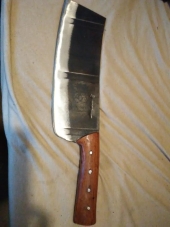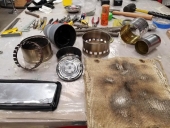I have been playing with increaseing efficiency of the small, cheap stainless steel Chinese TLUD (Top Lit Up Draft) wood gassifier camping stoves lately being sold on Ebay, Amazon & etc.:
https://www.ebay.com/itm/Ohuhu-Camping-Stove-Backpacking-Stove-Potable-Stainless-Steel-Wood-Burning/302948648290?epid=14016200784&hash=item4689258562:g:9ckAAOSw6oBXFRXQ
See page 8 here for my history on that project with a few pictures-
https://classiccampstoves.com/threads/chinese-wood-gassifier-stove.37401/page-8
And for the last week, I've been sitting several hours a day in a deer stand, experiencing below freezing Minnesota weather and being very disatisfied with a propane fired IR heater. I can tell it's producing some CO from the way I feel, plus it's either too hot (or turned off) in an 8' X 6' space with a 7' ceiling. There is about 2' of space under the floor...
I'm thinking abour using that space, combining a TLUD with some leftover masonry building materials on hand to make a variation on the "ondol".
https://permies.com/mobile/t/40500/Ondol-ancient-original-form-heating
That is, the center of the floor of the stand would be ceramic tile over a thermal mass of heated masonry, with a TLUD stove feeding its exhaust into this from below and me with nice warm feet and butt situated above. Ideally, this could be fired once a day in the morning, perhaps again in early afternoon. Heat doesn't need to be stored and released all night long, but would need to begin to be released into the space rather sooner after lighting than is usual for mass heaters.
I've found various resources linked on Permies in the rocket mass heater and wood heating forums regarding planning firebox & chimney size/draft requirements, fuel heat content- and I learned just enough about thermodynamics in school to be dangerous.
I need to identify materials with quick enough response to get some heat out of the floor within an hour or so of lighting the stove- Not waiting half a day for the mass to conduct heat into the space as is common for a home heating "rocket mass heater" setup.
Any suggestions?
Thanks,
Bert
(Edit)
Starting to dig out some answers, from Permies and elsewhere-
A handbook of refractory properties, I have included a table of conductivitie for refractory brick materials. No idea how much these cost, probably way too much if bought new. But that magnesite-Carbon brick is interesting...
https://www.google.com/url?sa=t&source=web&rct=j&url=http://mha-net.org/docs/Harbison%2520Walker%25202005%2520Handbook.pdf&ved=2ahUKEwjWiqKD2s_eAhVI1IMKHT8tBWo4ChAWMAR6BAgAEAE&usg=AOvVaw1QrcV6geGLlF06fdBsIR8N
This thread provided a table of conductivities, which I have clipped the "interesting" end of as a screen shot and attached below.
https://permies.com/mobile/t/18864/thermal-mass-materials
First ideas for some cheap, relatively high conductive thermal mass?
I have a fair ammount of natural stone tile scraps and leftover tile from doing my girlfriend's basement floors and bathroom walls, these look like good candidates- Tiles I used were marble and granite. Both are among the highest conductivity of natural materials, yet not too shabby in specific heat.
Whoa, emmisivity coefficient of white marble is listed as .95!
That tile should be able to conduct AND radiate heat pretty fast.
https://www.google.com/amp/s/www.engineeringtoolbox.com/amp/emissivity-coefficients-d_447.html








